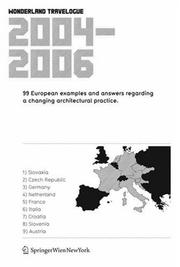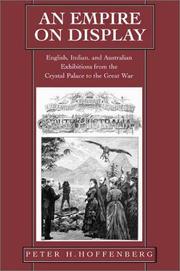| Listing 1 - 10 of 64 | << page >> |
Sort by
|

Abstract | Keywords | Export | Availability | Bookmark
 Loading...
Loading...Choose an application
- Reference Manager
- EndNote
- RefWorks (Direct export to RefWorks)
Architecture --- Europe --- 1990-.... --- Expositions

ISBN: 0520922964 1597345946 9780520922969 0585394695 9780585394695 9780520218918 0520218914 9781597345941 Year: 2001 Publisher: Berkeley University of California Press
Abstract | Keywords | Export | Availability | Bookmark
 Loading...
Loading...Choose an application
- Reference Manager
- EndNote
- RefWorks (Direct export to RefWorks)
The grand exhibitions of the Victorian and Edwardian eras are the lens through which Peter Hoffenberg examines the economic, cultural, and social forces that helped define Britain and the British Empire. He focuses on major exhibitions in England, Australia, and India between the Great Exhibition of 1851 and the Festival of Empire sixty years later, taking special interest in the interactive nature of the exhibition experience, the long-term consequences for the participants and host societies, and the ways in which such popular gatherings revealed dissent as well as celebration.
Exhibitions --- Exhibits --- Expos (Exhibitions) --- Expositions --- Industrial arts --- Industrial exhibitions --- International exhibitions --- Technology --- World's fairs --- Sales promotion --- Fairs --- History.
Book
ISBN: 9781621900788 1621900789 9781572338654 1572338652 Year: 2014 Publisher: Knoxville The University of Tennessee Press
Abstract | Keywords | Export | Availability | Bookmark
 Loading...
Loading...Choose an application
- Reference Manager
- EndNote
- RefWorks (Direct export to RefWorks)
Exhibitions --- Exhibits --- Expos (Exhibitions) --- Expositions --- Industrial arts --- Industrial exhibitions --- International exhibitions --- Technology --- World's fairs --- Sales promotion --- Fairs --- History
Book
ISBN: 1526134810 1526158280 1526134799 9781526134806 1526134802 9781526134790 Year: 2021 Publisher: [Place of publication not identified] MANCHESTER UNIV Press
Abstract | Keywords | Export | Availability | Bookmark
 Loading...
Loading...Choose an application
- Reference Manager
- EndNote
- RefWorks (Direct export to RefWorks)
Deco dandy contests the supposedly exclusive feminine aspect of the style moderne (art deco) by exploring how alternative, parallel and overlapping experiences of decorative modernism, nationalism, gender and sexuality in the years surrounding World War I converge in the protean figure of the 'deco dandy'. The book suggests a broader view of art deco by claiming a greater place for the male body, masculinity and the dandy in this history than has been given to date.
Art and society --- History --- Art Deco. --- France. --- Modernism. --- art history. --- dandy. --- design history. --- fashion. --- gender. --- international expositions. --- masculinity. --- queer.
Book
ISBN: 9020945084 Year: 2002 Publisher: Tielt Lannoo
Abstract | Keywords | Export | Availability | Bookmark
 Loading...
Loading...Choose an application
- Reference Manager
- EndNote
- RefWorks (Direct export to RefWorks)
menselijk lichaam --- Peere, Piet --- Art contemporain --- Catalogues d'expositions --- Hedendaagse kunst --- Tentoonstellingscatalogi --- Figurative expressionism --- -schilderkunst --- België --- eenentwintigste eeuw --- Art, Modern --- Expressionism (Art) --- Figurative art --- schilderkunst --- Peere, Piet,
Book
ISBN: 9782753520578 2753520577 9782869062849 2869062842 2869068174 Year: 2012 Publisher: Rennes: Tours: Presses Universitaires de Rennes, Presses universitaires François-Rabelais de Tours,
Abstract | Keywords | Export | Availability | Bookmark
 Loading...
Loading...Choose an application
- Reference Manager
- EndNote
- RefWorks (Direct export to RefWorks)
À travers deux expositions universelles, celle de 1889 et celle de 1900, au cours desquelles les visiteurs ont « engouffré une masse gargantuesque de victuailles », ce travail s’attache à suivre dans des « lieux vivants », le marché de la restauration, les consommateurs en mouvement, les pratiques plus populaires comme les pique‐niques sur les pelouses ou les usages mondains dans des restaurants gastronomiques. Si l’historiographie des expositions est bien fournie et que les travaux sur l’alimentation ne manquent pas, personne n’avait encore songé à croiser ces deux traditions. Sous l’angle de la consommation alimentaire, une activité qui répond à un besoin physiologique mais qui est aussi porteuse de nombreuses significations culturelles et sociales, le livre avance l’idée qu’au delà de leur dimension symbolique et de leurs stratégies représentationnelles, les expositions universelles doivent être avant tout appréhendées en tant qu’espaces vivants qui impliquent une gestion biopolitique de la part des organisateurs, une économie affective dans la pratique du marché de la restauration et une expérience corporelle des lieux pour les visiteurs. Alors que les travaux actuels sur les méga‐événements tendent à proposer soit une analyse de leurs retombées économiques, soit un regard critique qui déconstruit la construction de discours et d’identités, il apparaît plus pertinent de se pencher sur l’épaisseur temporelle de l’événement et sur l’épaisseur anthropologique d’une telle manifestation autour de l’alimentation.
Food habits --- Exhibitions --- Habitudes alimentaires --- Expositions internationales --- History --- Histoire --- Exposition universelle de 1889 --- Exposition universelle internationale de 1900 --- Exposition universelle --- culture --- histoire --- alimentation --- représentation --- gastronomie
Book
ISBN: 1487576021 9781487576028 9781487576882 Year: 1967 Publisher: Toronto
Abstract | Keywords | Export | Availability | Bookmark
 Loading...
Loading...Choose an application
- Reference Manager
- EndNote
- RefWorks (Direct export to RefWorks)
The novelist Paul Morand described the Exposition of 1900 in Paris: ... a new and ephemeral city hidden in the centre of the other, a whole quarter of Paris in fancy dress, a ball, where the buildings were the masqueraders. To our childish eyes it was a marvel, a coloured picture book, a save filled by strangers with treatures. Masked in this swirl of colour and noise was an event for the political, scholarly, literary, and financial elite of all nations, an occasion for demonstrating the many preoccupations of the intellectuals of the age. Like all the World's Fairs of the nineteenth century, this was an opportunity for the awarding of excellence: the awards or lack of them could make or break an artist, craftsman, or inventor who offered his skills for judgment by the international juries; it was the arena where careers were launched or ended, fortunes made or destroyed, reputations of great firms established or ruined. And in one major respect the Paris World's Fair would never be equalled: it was the last time that it was thought possible to include all of man's activity in one display. The author of this study believes that the World's Fair can teach us much about the past; being international and representative, they are summations of culture at particular points int he development of our civilization. They are kaleidoscopic pictures of the times. Professor Mandell uses the Paris Exposition as an approach to the traditional, political, and intellectual problems of France and the world at the turn of the century. This original approach offers fresh sources of information on such topics as the Dreyfus Affair, the clash between Art Nouveau and Victorian Baroque, French diplomacy (especially relations with Germany before 1914) and the various countries' progress in the field of science. Fully illustrated, this study will appeal to amateur and professional historians, to sociologists, economists and anyone interested in international relations, trade, and advertising.
Exhibitions --- Exhibits --- Expos (Exhibitions) --- Expositions --- Industrial arts --- Industrial exhibitions --- International exhibitions --- Technology --- World's fairs --- Sales promotion --- Fairs --- France --- City of Paris --- Paris
Book
ISBN: 0822987066 9780822987062 9780822945765 0822945762 Year: 2019 Publisher: Pittsburgh, Pa.
Abstract | Keywords | Export | Availability | Bookmark
 Loading...
Loading...Choose an application
- Reference Manager
- EndNote
- RefWorks (Direct export to RefWorks)
"When the Reverend Henry Carmichael opened the Sydney Mechanics' School of Arts in 1833, he introduced a bold directive: for Australia to advance on the scale of nations, it needed to develop a science of its own. Prominent scientists in the colonies of New South Wales and Victoria answered this call by participating in popular exhibitions far and near, from London's Crystal Place in 1851 to Sydney, Melbourne, Adelaide, and Brisbane during the final decades of the nineteenth century"--
Exhibitions --- Science --- Natural science --- Natural sciences --- Science of science --- Sciences --- Exhibits --- Expos (Exhibitions) --- Expositions --- Industrial arts --- Industrial exhibitions --- International exhibitions --- Technology --- World's fairs --- Sales promotion --- Fairs --- History
Book
ISBN: 0271085266 027108524X Year: 2019 Publisher: University Park, Pennsylvania : The Pennsylvania State University Press,
Abstract | Keywords | Export | Availability | Bookmark
 Loading...
Loading...Choose an application
- Reference Manager
- EndNote
- RefWorks (Direct export to RefWorks)
"Uses Spanish participation at a series of international exhibitions to explore the transnational histories of Spain, the United States, Europe, and America in order to understand how and why the Spanishness of U.S. national identity has been subverted, marginalized, and largely forgotten"--
Exhibitions --- Art, Spanish --- History. --- United States --- Civilization --- Spanish influences. --- America. --- Latin America. --- Mexican-Americans. --- Spain. --- World's Fairs. --- expositions. --- national identity. --- the United States. --- transnational studies.
Book
ISBN: 9789462985636 9789048536788 9048536782 Year: 2020 Publisher: Amsterdam
Abstract | Keywords | Export | Availability | Bookmark
 Loading...
Loading...Choose an application
- Reference Manager
- EndNote
- RefWorks (Direct export to RefWorks)
International expositions or "world's fairs" are the largest and most important stage on which millions routinely gather to directly experience, express, and respond to cultural difference. Rather than looking at Asian representation at the hands of colonizing powers, something already much examined, Asian Self-Representation at World's Fairs instead focuses on expressions of an empowered Asian self-representation at world's fairs in the West after the so-called golden age of the exhibition. New modes of representation became possible as the older "exhibitionary order" of earlier fairs gave way to a dominant "performative order," one increasingly preoccupied with generating experience and affect. Using case studies of national representation at selected fairs over the hundred-year period from 1915-2015, this book considers both the politics of representation as well as what happens within the imaginative worlds of Asian country pavilions, where the performative has become the dominant mode for imprinting directly on human bodies.
Self-perception --- National characteristics, Asian. --- Exhibitions --- Self-concept --- Self image --- Self-understanding --- Perception --- Self-discrepancy theory --- Self-evaluation --- Exhibits --- Expos (Exhibitions) --- Expositions --- Industrial arts --- Industrial exhibitions --- International exhibitions --- Technology --- World's fairs --- Sales promotion --- Fairs --- Asian national characteristics --- History. --- Asian self-representation Asian modernities Asian cultural flows Performance and performativity international expositions.
| Listing 1 - 10 of 64 | << page >> |
Sort by
|

 Search
Search Feedback
Feedback About UniCat
About UniCat  Help
Help News
News